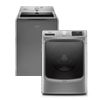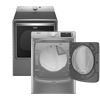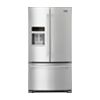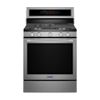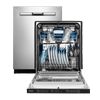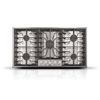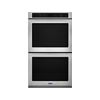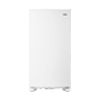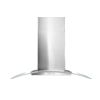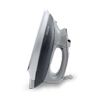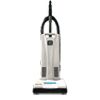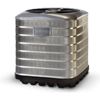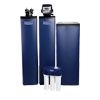Getting the Best Results when Using a Dishwasher
Getting the Best Results when Using a Maytag Dishwasher
Proper loading, using rinse aid, setting the water temperature, using the correct cycle, and maintaining your dishwasher can all help achieve the best results. Review the tips and suggestions below.
Water Temperature
To minimize cycle time, run the hot water faucet at the sink closest to the dishwasher until the water is hot; as part of normal operation, having hot water enter the dishwasher right when the cycle begins can eliminate the need for long heating pauses, decreasing the time it takes to complete the cycle.
Hot water dissolves and activates the dishwashing detergent. Hot water also dissolves grease on dishes and helps glasses dry spot-free. If the water temperature is too low, loads may not wash well.
Use Rinse Aid
Your dishwasher utilizes a rinse aid to assist with drying performance. Without a rinse aid, the interior of your dishes and dishwasher could be subject to excessive moisture. The heat-dry option can perform better with a rinse aid. Rinse aid can improve drying and reduce water spots and filming. Water "sheets" off dishes rather than forming water droplets that cling and leave spots.
Be sure to fill the dispenser before you use your new dishwasher. A full dispenser holds about 5 oz (150-175 mL) of rinse aid and should last about a month. Make sure the rinse aid dispenser is full. It is recommended to use a colored rinse aid, such as blue, so you can more easily see the rinse aid level in the gauge.

Proper Loading
Loading a dishwasher is the first step to using the appliance properly and getting optimal cleaning results.
- Top Rack: We recommend using the upper rack for bowls and cups. Cups should be placed face down—load items at an angle.
- Bottom Rack: We also recommend using the lower rack for plates, pots/pans, and utensils. Ensure all plates are slotted into the rack on their side.
- Plastics: Load items at an angle on the top rack. Ensure all items are designated as "Dishwasher Safe". Plastics are difficult to dry because they have a porous surface and tend to collect droplets. Plastic items take longer to dry and may not dry completely in a normal dry cycle, so let them air dry.
- Silverware: Use silverware basket lids to provide optimal spacing and best cleaning performance. If your silverware does not fit into the designated slots, open the lids or lift on the ends of the lids and pull to remove (depending on the silverware basket type). Mix different types of silverware to keep them separate. Load knives down, forks up, and alternate spoons for best cleaning results.
Visit Using Dishwasher Features for Improved Loading for more tips
Pick the correct cycle and modifiers.
- Choose the cycle that describes the most difficult soil in your dishwasher.
- Ensure all dishes are labeled as "Dishwasher Safe."
- Using a heated dry cycle is the best way to ensure your dishes will dry at the end of the cycle. There may still be some moisture, especially on the upper rack or on plastic items, but a heated dry cycle gives the best drying results. If a heated dry cycle is not used, it is recommended to open the dishwasher door when the cycle has completed.
Energy Saving Tips
- Do not rinse dishes before putting them into the dishwasher to save water, energy, and time.
- Use a low-energy, quick, or short cycle. These cycles use less hot water and energy than a normal cycle.
- Use a delay feature (available on some models) to run your dishwasher during off-peak hours. Local utilities recommend avoiding heavy usage of energy at certain times of day.
- During the summer, run your dishwasher at night. This reduces daytime heat buildup in the kitchen.
Clean the dishwasher
Clean your dishwasher with affresh® Dishwasher Cleaner every 30 days to keep your dishwasher fresh and clean.
Cleans even where you can't see
affresh® cleans deep inside your appliances reaching components such as the tub, racks, pump, valves, drain, and recirculation hoses.
Cleaners are available at many retailers or can be purchased here at affresh®.



